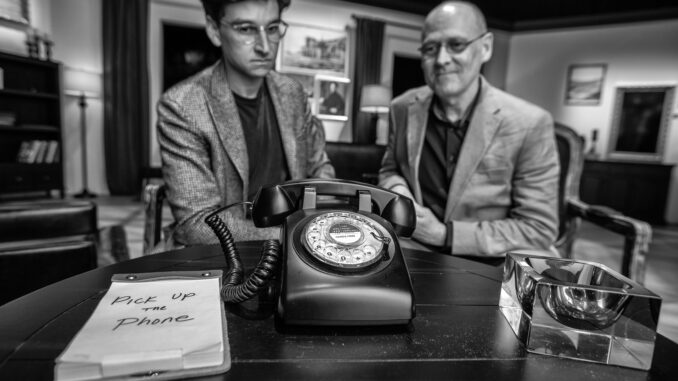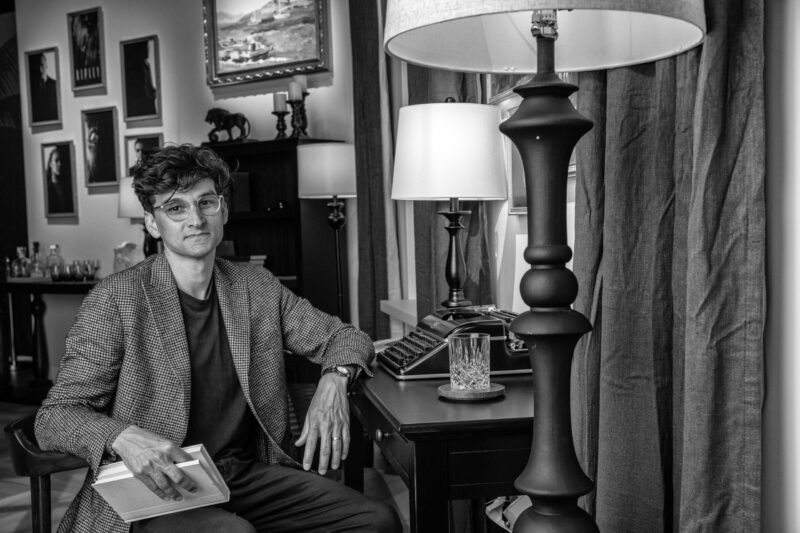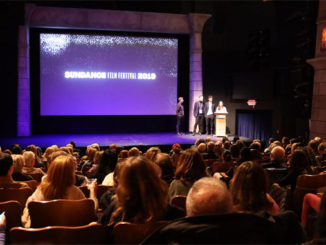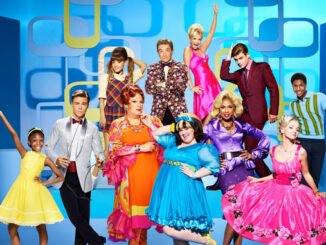
By Kristin Marguerite Doidge
When the audience first meets the grifter Tom Ripley in the eponymous new limited series drama, “Ripley,” he’s dragging a dead body down a long flight of stairs in the dark: clunk, clunk, clunk. The sinister moment draws us in — and somehow, seemingly makes us complicit in the crime.
But it wasn’t scripted that way. The moment is an example of how writer-director Steven Zaillian (who won an Academy Award for his script for “Schindler’s List”) opened himself up to the possibilities of reworking his own material in post-production. “This flash forward is something we discovered in post that could serve as a lodestar to signal to the audience where we were going while simultaneously buying us some time to set things up at the slower pace that the cinematography and the direction dictated,” said picture editor Joshua Lee.
‘From the beginning, we were on borrowed time.’
The series, which is based on Patricia Highsmith’s bestselling Tom Ripley novels, is set in the winter of 1960. Its stylish eight hour-long episodes focus on Ripley (played by Andrew Scott) after he’s hired by a wealthy man to travel from New York to Italy to convince the man’s vagabond son “Dickie” (played by Johnny Flynn) to return home. Ripley’s acceptance of the job is the first step into a complex life of deceit, fraud, and murder. F
ellow picture editor David O. Rogers, who previously worked with Zaillian as first assistant editor on his critically acclaimed 2016 HBO miniseries, “The Night Of,” said that Zaillian began as a picture editor himself and therefore was not only open to deviating from his own script and reworking it in post-production, but was fearless in doing so.
Episode 1, for example, significantly changed from the script in order to get the audience to the infamous boat scene (in Episode 3) sooner, Lee said, adding, “There was a lot of compression of the New York narrative action that took place. Steve was aware from the beginning that we would be on borrowed time. The way the New York sequence was originally scripted and the way it was timing out in early cuts was just too long…some scenes of Ripley leaving town ended up essentially being condensed into a two-minute montage.”
TWO YEARS OF POST
The “good graces” of Netflix allowed Zaillian the time he needed for editing – nearly two years in total – which the post-team thought resulted in a stronger show. “You don’t normally get that much time on a television series,” Lee added. “The approach of the series was always a lot more like the approach of a feature film, both the scheduling of it and the scale of it. And just the fact that it was a writer-director, an auteur filmmaker at the helm, meant that we were always thinking of it as one large feature film.”

Likewise, for Zaillian, the extended period of air time allowed for more visual exploration of Ripley’s motivations through Highsmith’s descriptions of events that occur in real time and which she describes in great detail in the novel. Another important element of capturing the film noir quality of the source material was shooting in black-and-white. Zaillian and his cinematographer, Robert Elswit, spent more than 150 days shooting all over Italy, from Sicily to Venice, filming in city streets, piazzas, houses, buildings and churches to provide a sprawling landscape for the story to unfold.
While allowing for a more abstract viewing experience for the audience, the neutral color palette initially created a challenge for the post-team in Avid. “I think Steve at some point said he didn’t want to even accidentally see the color media,” Rogers said. “For doing temp green-screen comps, we initially had this process of switching over to the color media for a sequence, pulling a key, creating an alpha channel, bringing that alpha channel media back into the black-and-white project, but it was going to take forever. So we switched over to just use color media for the whole edit, and we just monitored it in black-and-white. It saved us a lot of time and headache.”

Another challenging but ultimately rewarding experience for Rogers was the edit of a particular scene in Episode 4 in which Ripley is packing up the paint brushes and tools in Dickie’s art studio.
“While Marge [played by Dakota Fanning] and Tom are having this conversation, there was a lot of blocking going on and prop movement, and it was shot on the angles of Tom doing all this stuff with an A and B camera,” he explained. “And so the B camera was usually following Tom as the insert, so we had a lot of different takes of him throwing boxes and things into a suitcase and moving and turning. That was a scene that is a bit of a dance to try to get everything to land just right with the lines. And so Steve had me try one where it was just all on Tom with no cuts to Marge, just to work on the blocking, trying the inserts and things, and then start to weave Marge’s component into it. It was a fun sort of puzzle to finally put together, and I feel I’m very satisfied with the flow of that scene and the objects and the way things work.”
For Lee, it was the end montage — which wasn’t scripted at all — that proved to be the most gratifying to edit.
“The original ending that was scripted could not be shot because basically the camera would’ve had to be underwater at the bottom of a canal in Venice, and that wasn’t feasible,” he said. “We experimented with animation and seeing whether we could do it in CG and it didn’t feel right. The idea emerged of a montage coming out of Tom’s focus on a painting and a vision he would sort of have. It was a delicate dance between the images that he would see so it wouldn’t just be a recap of the series. We wanted something more along the lines of a revisionist narrative in Tom’s mind of himself as a great artist like Caravaggio or Picasso — that he’s reflecting on his work by looking at this painting.” The final product provides an emotional punch and was the result of the entire picture editorial team’s ideas and collaboration, from Rogers and Lee, to first assistant editor Lillian Pachter (who provided additional editing on three episodes), to the assistant editors, Devon Halliday and Michael Crocitto Kenny.
It’s also emblematic of the dark and light nature of the work Zaillian has become known for.
“It was a very strong team dynamic,” Lee said. “We always joke that Steve is sort of the unofficial third editor of the show because he began his career as an editor, and he’s always said that it’s the part of the process feels most comfortable with and has the most fun with.”

As for capturing the sounds of Italy and adding dimension to the story, Rogers said each episode has its own creepy soundscape under the end credits that preview the next episode, thanks to the talents of the Foley and sound teams. “We knew as we were creating these things — doors closing, footsteps, creaking — that very few people were going to hear them, but they’re there,” he said. “And then Episode 8 has something too, so we’ll leave it to anyone who wants to listen to the end of Episode 8 to decide what they think.”
‘It was a very strong team dynamic.’
The show’s music selection (led by music supervisor Kier Lehman) was also an important way for the editors to build energy around the freewheeling and fun 1960s Italian culture that sets the stage for the darker moments that happen later on. Songs from Italian singers Mina and Tony Renis, for example, were specifically scripted, while others were added to the final mix through experimentation, with an ear for authenticity.
The same went for the foreboding score composed by Jeff Russo, Lee said. “He found his own way of interpreting that classical sound, but I think that energy of a Bernard Hermann score — a suspense thriller Hitchcock-type score — is in the bones of what he created,” he added.
After the long road to the show’s premiere this spring, Rogers said the response from fans and critics has been truly special.
“There’s a feeling of relief because after all that work and all the sort of obsessive detail that you sweat over, we felt like, ‘well, this is amazing.’ But we’re very close to it, and so, to actually have it out in the world and see that people are responding to those things that we all were working so hard on, it’s gratifying,” he said.
And it’s Zaillian’s meticulous attention to every frame that the team will remember most about this project and will take with them into the future: “All of these things, like the source music and the score and the sound design, and the way things look – every detail – we’ll all take that kind of discipline and attention into the next job.”





